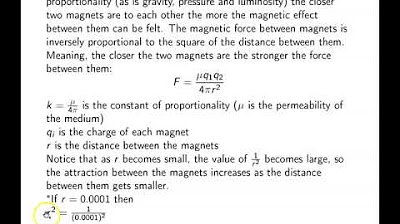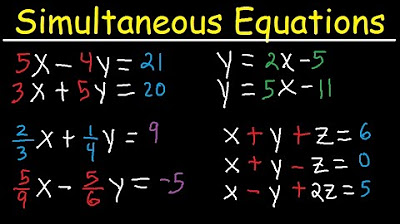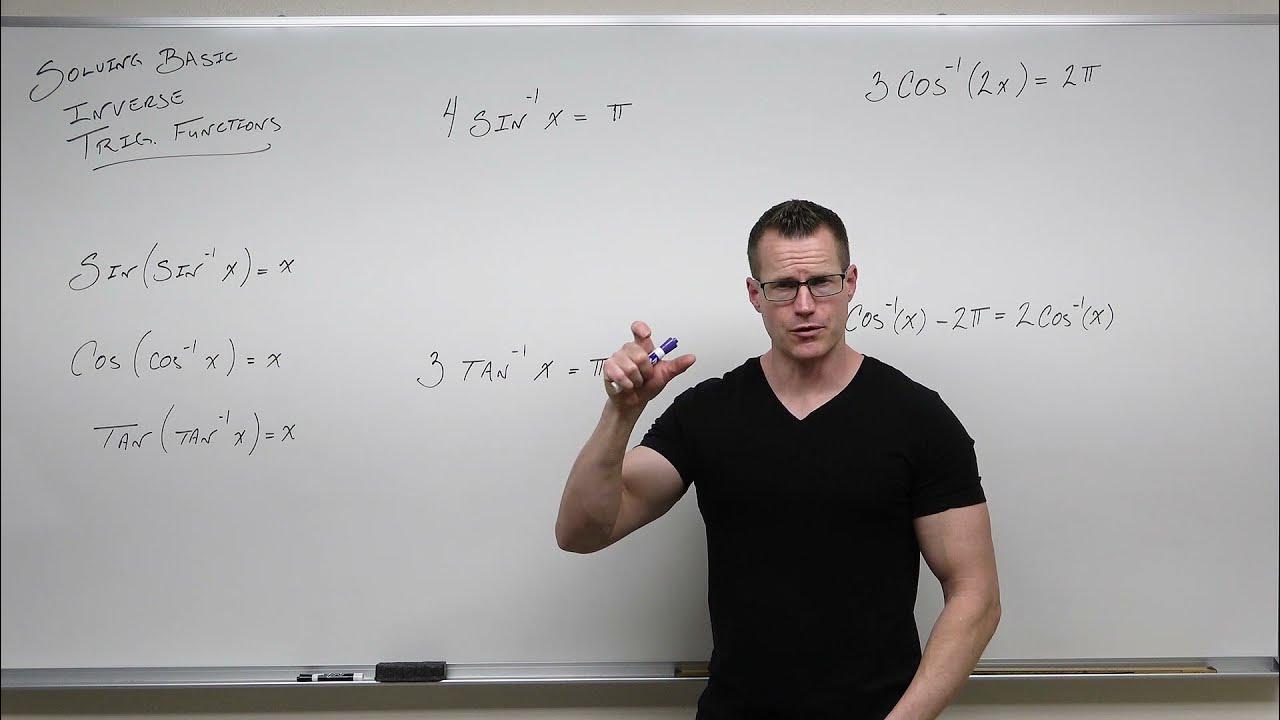Direct Inverse and Joint Variation Word Problems
TLDRThis instructional video script offers a comprehensive guide to solving word problems involving direct, inverse, and joint variation. It begins by teaching how to formulate equations for each type of variation, including direct, inverse, and joint variations with multiple variables, as well as variations involving powers and roots. The script then illustrates the process of solving these problems both conceptually and algebraically, using step-by-step examples. It emphasizes understanding the proportional relationships and the impact of changing variables on the outcome, ultimately enabling viewers to tackle a variety of word problems with confidence.
Takeaways
- 📚 Direct Variation: The script explains that if 'y' varies directly with 'x', the equation is y = kx, where 'k' is the constant of variation.
- 🔄 Inverse Variation: It clarifies that if 'y' varies inversely with 'x', the equation is y = k/x, showing a relationship where as one variable increases, the other decreases.
- 🔗 Joint Variation: The concept of joint variation is introduced, where 'y' varies with multiple variables, like y = k * x * z, indicating a direct relationship with each variable.
- 🔄📏 Combined Variation: The script covers combined direct and inverse variation, such as y = k * x / z, where 'y' increases with 'x' and decreases with 'z'.
- 📈 Variation with Powers: It discusses variation with powers, for example, y = k * x^2, where 'y' is directly proportional to the square of 'x'.
- 📉 Inverse Variation with Roots: The script explains inverse variation with roots, like y = k / √x, where 'y' varies inversely with the square root of 'x'.
- 🔢 Solving for 'k': The process of solving for the constant 'k' using given values of variables is demonstrated, which is essential for solving word problems.
- 🔍 Conceptual Understanding: The importance of understanding the conceptual increase or decrease of variables in direct and inverse relationships is emphasized.
- 📘 Algebraic Solution: The script provides step-by-step algebraic methods to solve for unknown variables in various types of variation problems.
- 📝 Word Problems: Several word problems are presented to illustrate how to apply the equations of variation to real-world scenarios.
- 📊 Proportional Changes: The script explains how to calculate proportional changes in variables, such as doubling or tripling, in the context of direct and inverse variation.
Q & A
What is the basic equation for direct variation when y varies with x?
-The basic equation for direct variation when y varies with x is y = kx, where k is the constant of variation.
How do you represent the equation for inverse variation when y varies with x?
-The equation for inverse variation when y varies with x is y = k / x, where k is the constant of variation.
If y varies directly with both x and z, what is the form of the equation?
-When y varies directly with both x and z, the equation is y = k * x * z, where k is the constant of variation.
What is the equation for y varying directly with x but inversely with z?
-The equation for y varying directly with x but inversely with z is y = k * x / z, where k is the constant of variation.
How would you write the equation if y varies directly with the square of x?
-If y varies directly with the square of x, the equation is y = k * x^2, where k is the constant of variation.
What happens to y when x triples if y varies directly with x?
-If y varies directly with x and x triples, y will also triple, maintaining the direct proportionality.
How does the value of y change when x doubles if y varies inversely with x?
-If y varies inversely with x and x doubles, y will be halved, reflecting the inverse relationship.
If y varies jointly with x and z, and x and z both double, by what factor does y increase?
-If y varies jointly with x and z, and both x and z double, y will increase by a factor of four, as the effect is multiplicative.
What is the equation for y varying inversely with the cube of x?
-The equation for y varying inversely with the cube of x is y = k / x^3, where k is the constant of variation.
How do you determine the value of k in a direct variation problem?
-To determine the value of k in a direct variation problem, use the known values of y and x, plug them into the equation y = kx, and solve for k.
Can you provide an example of solving a joint variation problem using the script's method?
-Yes, for a joint variation problem like y varies with x and z, first find k using the initial values (e.g., y = 36 when x = 2 and z = 3), then use the new values of x and z to find the new y using the equation y = k * x * z.
Outlines
📚 Introduction to Direct and Inverse Variation
This paragraph introduces the concepts of direct and inverse variation, as well as joint variation, in the context of word problems. It explains how to formulate equations for direct variation (y = kx), inverse variation (y = k/x), and joint variation with two variables (y = k * x * z). The paragraph also covers variations involving squares and cubes, and roots, providing a foundational understanding necessary to approach word problems involving these mathematical relationships.
🔍 Solving Direct Variation Problems
This section focuses on solving direct variation problems using equations. It demonstrates how to determine the constant of variation (k) using given values and then apply this constant to find unknown values when variables change. An example is provided where y varies directly with x, and the problem is solved both conceptually and algebraically to show the proportional increase in y when x is tripled.
📉 Understanding Inverse Variation and Its Solutions
This paragraph delves into inverse variation, where as one variable increases, the other decreases. The equation y = k/x is used to solve for k with given values, and then predict and confirm the change in y when x is doubled. The explanation emphasizes the inverse relationship, where an increase in x results in a proportional decrease in y.
🤔 Joint Variation and Conceptual Problem Solving
The concept of joint variation is explored in this paragraph, where y varies with multiple variables, either directly or inversely. The paragraph provides a step-by-step guide to solving such problems, starting with writing the correct equation (y = k * x * z), solving for k, and then using the values to find the new y when the variables change. The explanation includes both a conceptual understanding and a mathematical approach to ensure the solution is correct.
📐 Advanced Variations Involving Powers and Roots
This section tackles more complex variations involving powers and roots. It explains how to set up and solve equations for scenarios where y varies directly with the square or cube of x and inversely with the cube or square of z. The paragraph illustrates the process of solving for k and then using this to find the new value of y when the variables change, emphasizing the need to consider the effects of powers and roots in the calculations.
📝 Conclusion on Conceptual and Algebraic Problem Solving
The final paragraph concludes the discussion by summarizing the ability to solve problems both conceptually and algebraically. It reinforces the importance of understanding the underlying mathematical relationships and being able to apply them to find solutions to word problems involving direct, inverse, and joint variations.
Mindmap
Keywords
💡Direct Variation
💡Inverse Variation
💡Joint Variation
💡Equation
💡Word Problems
💡Constant of Proportionality (k)
💡Square
💡Cube
💡Square Root
💡Conceptual Understanding
💡Algebraic Solution
Highlights
Introduction to direct, inverse, and joint variation word problems.
Writing equations for direct variation where y = kx.
Equations for inverse variation with y = k/x.
Formulating joint variation equations like y = k * x * z.
Understanding mixed variation: direct with one variable and inverse with another.
Equation for variation directly with the square of a variable: y = kx^2.
Inverse variation with a square root: y = k / √x.
Complex variation involving direct with a cube and inverse with a square: y = kx^3 / z^2.
Solving a direct variation problem with given values to find k.
Conceptual understanding of how increasing x affects y in direct variation.
Inverse variation problem where increasing x causes y to decrease.
Using equations to confirm conceptual understanding of inverse variation.
Joint variation problem with y dependent on both x and z.
Conceptual approach to solving joint variation by understanding the effect of doubling variables.
Algebraic solution for joint variation using the equation y = k * x * z.
Direct variation with the square of x, doubling x results in quadrupling y.
Inverse variation with the cube of x, tripling x results in y divided by 27.
Final problem involving direct variation with the cube of x and inverse with the square of z.
Conceptual and algebraic solutions for complex variation problems.
Transcripts
Browse More Related Video

Ch. 1.12 Modeling Variation

Simultaneous Equations - Tons of Examples!

Substitution Method For Solving Systems of Linear Equations, 2 and 3 Variables, Algebra 2

How To Solve Word Problems of Any Kind . Nutshell maths-2

How to Solve Basic Inverse Trigonometric Functions (Precalculus - Trigonometry 20)

Sine & Cosine Graphs Word Problems (Writing the Equation)
5.0 / 5 (0 votes)
Thanks for rating: